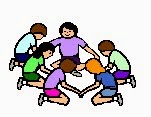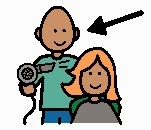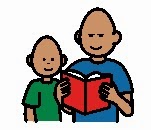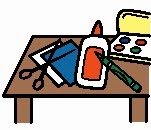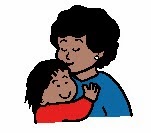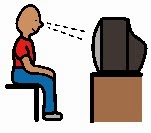 Being well prepared for any situation can make all the difference for a successful outcome. This is often the case when we think about providing positive communication support for people who use AAC. When we know what will help an individual to get their message across successfully, both communication partners feel more comfortable and messages are given and received more easily. This month we are featuring information about Communication Passports: a great way to share information about a person's communication profile.
Being well prepared for any situation can make all the difference for a successful outcome. This is often the case when we think about providing positive communication support for people who use AAC. When we know what will help an individual to get their message across successfully, both communication partners feel more comfortable and messages are given and received more easily. This month we are featuring information about Communication Passports: a great way to share information about a person's communication profile. What is it?
A Communication Passport is a visually interesting and informative book (or booklet, flyer, place mat, etc.) that highlights information about a person's personality, likes & dislikes, communication strengths and needs. It is a way of presenting information that can be crucial in supporting successful interactions between a person who has difficulty communicating and their communication partners.
A Communication Passport is one of the communication tools that is described in the You Tube video entitled "Knowing Me: Communication Tools for Transition".
Why is it important?
Children and adults who have complex communication needs may express themselves in a wide variety of ways, not necessarily using speech or other more conventional methods of communication. Some of our students use very specific methods to communicate, perhaps including some subtle body movements or gestures that might be easily missed when you don't know quite what you are looking for. A Communication Passport can help you get to know exactly how a person communicates and how you can help.
 Who is it for?
Who is it for? A Communication Passport is intended to get the basics about how best to support a person's communication to those who need it.
Anyone who is new in your student's life: a substitute teacher, a new educational assistant, respite workers, summer camp counselors. These people often have limited time to get to know an individual who uses AAC. A Communication Passport can help them to understand the basics that might make interactions more successful. Highlight the most important pages in the passport that you want these people to read.
People you meet infrequently: doctors, dentists, hairdressers, the specialist who is coming to complete an assessment. Sharing information with these people quickly and easily may help to make these "special events" in a person's life more positive and successful.
Peers, classmates: sharing information that can promote positive communication experiences with peers is so important for our students.
Extended family members: grandparents, aunts, uncles and cousins who do not have a lot of experience with interacting with someone who uses an alternative form of communication may benefit from the additional information that is captured in these documents. It can serve as a reminder when grandparents come to baby-sit. Or as a way to introduce a few tips to make communication more successful during a family occasion.
Where to keep it:
If you put in the effort to make a communication passport, you want people to read it. You want to make sure that it is visible and handy for everyone to read when they have a few minutes to do so. Keep a communication book where it is needed - hang it on the back of a wheelchair where others can see it. Make the cover interesting and add a message that invites others to look inside. Think about letting others know that the book is new and invite them to come and take a look.
Consider the content of what's contained inside the book. Whenever possible, involve the person you are making the book for, so that he or she knows what is included and is happy to share that information with others. Keep privacy issues in mind when sharing information about personal needs or any topics of a sensitive nature.
Make it personal:
Let's be honest, reading a report about someone's communication abilities and needs can be pretty dull, no matter how important the information contained within it. A Communication Passport is not a formal document. It should scream "Read Me!". People who notice it hanging off the back of a chair should be intrigues and curious and itching to open the cover. You can show some of the individual's personality throughout this book. Create a funky cover, add photographs and quotes. Make it something to be proud of and something that others really want to read.
How do I make one?
Step by step instructions for making Personal Communication Passports can be found on the CALL Scotland website. Here you will find templates (including variations such as Mini Passports), good practice guidelines for creating the document (including a checklist to evaluate the outcome of creating the passport) and tips and information that will be helpful as you work your way through the process. There is a great collection of articles that can be downloaded. "Introduction to Passports" by Sally Millar makes a great handout to share with others, detailing what a passport is all about.
Who can help me make a passport?
There is a lot of information online that will help you to create a passport for your child or family member. If you need some support, a Speech and Language Pathologist may be able to work with you. Sometimes you may find that someone in your child's class can lend a hand - this may be something that a DSW student can work on during a placement at the school. Not only will it allow that person to get to know your child, but may give them an opportunity to learn about a resource that may be helpful to them throughout their career. Think about involving your child's siblings or peers when pulling the information together to put into a passport. Sometimes peers look at things differently and they may have interesting insights about what's important to your child.
Updating:
People change and passports need to change too, to reflect what's different. This is one good reason to keep a passport simple and to keep a back up copy that can be edited easily. Think about a way of putting your passport together that will allow you to change a single page at a time, rather than changing a whole book. Give yourself a deadline for updating the book each year, perhaps before school starts up again in September.
Passports for different reasons:
Emergency situations call for very specific information that can be found and used quickly and efficiently. This is not the time to be reading through a book of personal details, it is a time for the basics in an instant.
Here's a description of the Communication Passport for A&E resource from Praactical AAC:
"This Communication Passport is designed to give important information
about a person who uses AAC to healthcare professionals and first
responders in case of accident or emergency. It uses a stoplight
metaphor to guide the partner through important information, such as
emergency contacts, health conditions, medications, how the person takes
their medication, how to communicate with the person, and more."
The template is free to download.
My Health Passport - This passport has important information that allows health professionals to best support someone with complex communication needs while they are visiting a hospital or clinic.
Page Profiles are documents that summarize the supports that a person needs in order to participate to their full potential. Again, a quick and easy way to share information that might just make an experience successful. Typically, one page profiles contain 3 sections:
- ‘Appreciation’ – what people appreciate about the person, their character, gifts and talents
- ‘What is important to’ – what matters to them, from their perspective, about school and life
- ‘How to support’ – the ‘expertise’ from family, teachers and others about how to get the best out of the person
Keeping it simple
A Communication Passport does not have to be printed in colour, laminated and bound professionally. While we often want the finished product to be something that the user can be proud of, there are situations where sharing the information any way that we can is the most important thing. Here's an example of a project in Ghana , where Communication Passports were made with paper, pen and glue.
(Originally published on May 12, 2015 and updated December 2020)

